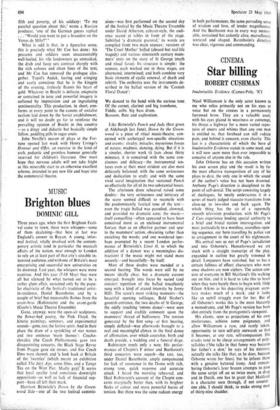Brighton blues MUSIC
DOMINIC GILL
Three years ago, when the first Brighton Festi- val came to town, there were whispers—some of them deafening—that here at last was England's answer to Royan. A young, infor- mal festival, vitally involved with the contem- porary artistic (and in particular the musical) affairs of the nation, near enough to London to rely on at least part of that city's sizeable in- terested audience, and with one of Britain's most enterprising and successful new universities on its doorstep. Last year, the whispers were more cautious. And this year (7-18 May) they were all but silenced by what turned out to be a rather glum affair, sustained only by the popu- lar electricity of the festival's traditional artist- in-residence, Daniel Barenboim, and by a couple of brief but memorable flashes from the avant-bras (Rubinstein) and the avant-garde (Goehr's Music Theatre Ensemble).
Gone, anyway, were the open-air sculptures, the flower-bed poetry, the Pink Floyd, the kinetic paintings, seminars, and experimental sounds—gone, too, the festive spirit. And in their place the draw of a sprinkling of star names and two ominous 'main themes': Czecho- slovakia (the Czech Philharmonic gave two disappointing concerts, the Black Stage Revue from Prague gave six revues, and five Czech films were shown), and 'a look back at Britain of the 'twenties' (which meant an exhibition called The Jazz Age, some films, and a Tango Tea on the West Pier. Madly gay)! It seems that local apathy (and sometimes downright opposition)—as well as lack of financial sup- port—have all left their mark.
Harrison Birtwistle's Down by the Green- wood Side—one of the two festival commis-
sions—was first performed on the second day of the festival by the Music Theatre Ensemble under David Atherton, cabaret-style, the audi- ence seated at tables in front of the stage. Subtitled 'a dramatic pastoral,' its words are compiled from two main sources: versions of `The Cruel Mother' ballad (absurd but real-life tragedy) and various nineteenth century mum- mers' texts on the story of St George (myth and ritual farce). Its structure is simple: the sources, each worked out in three stages, are alternated, intertwined; and both combine very basic elements of cyclic renewal, of death and rebirth. The orchestra uses the instruments de- scribed in the ballad version of the 'Cornish Floral Dance': We danced to the band with the curious tone, Of the cornet, clarinet and big trombone, Fiddle, cello, big bass drum, Bassoon, flute and euphonium.
Like Birtwistle's Punch and Judy (first given at Aldeburgh last June), Down by the Green- wood is a piece of ritual music-theatre, con- cerned with archetypal non-specific situations and events: rivalry, miracles, mysterious forces of nature, madness, dancing, dying. But if it is a simpler, shorter work (it lasts about thirty minutes), it is -conceived with the same con- ciseness and delicacy—the instrumental tex- tures even at their most strident are also most delicately balanced; with the same seriousness and dedication to craft; and with the same vivid aural imagination that sustained Punch so effectively for all of its two substantial hours.
The afternoon dress rehearsal raised some doubts: the very seriousness and intricacy of the score seemed difficult to reconcile with the predominantly farcical tone of the text— even the tragic ballad was parodied, downed, and provided no dramatic core; the music— itself compelling—often appeared to have been conceived more as an enclosed instrumental fantasy than as an effective partner and spur to the mummers' action, obscuring rather than enriching the words; and one wondered (per- haps prompted by a recent London perfor- mance of Birtwistle's Linoi II, to which the addition of a dancer was a meaningless dis- traction) if the music might not stand more securely—and beautifully—by itself.
Most of these doubts were mended at a second hearing. The words were still by no means ideally clear, but a dramatic current emerged, brought into focus by varied (and sinister) repetition of the ballad (excellently sung with a kind of crazed intensity by Jenny Hill). The score's most striking moments—the beautiful opening soliloquy, Bold Slasher's goonish entrance, the two deaths of St George, the oddly touching 'mimes dance'—were seen to support and craftily comment upon the mummers' thread of buffoonery. The tension generated by the first song—at first hearing, simply deflated—was afterwards brought to a real and meaningful climax in the final dance of affirmation, over which courtship, birth and death preside, a wedding and a funeral dirge.
Rubinstein needs only a note. His perfor- mances of Chopin's F minor and Beethoven's third concertos were superb—the tso, too, under Daniel Barenboim, amply compensated for lack of resonance in the Dome with rich, strong tone, quick response and accurate attack. I heard the morning rehearsal, and liked Rubinstein's account of the Chopin con- certo marginally better then, with its brighter flecks of colour and more powerful bursts of tension. But there was the same radiant energy
in both performances, the same pervading sense of wisdom and love, of tender magnificence. And the Beethoven was in every way memor- able, restrained but ardently alive, marvellously textured and shaped. Barenboim's direCtioh
was clear, vigorous and commanding. ,






































 Previous page
Previous page